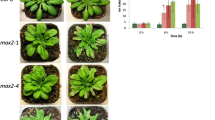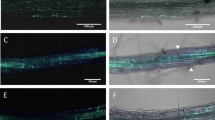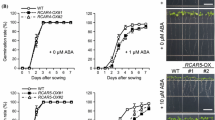Abstract
Raphanusanin (Ra) is a light-induced inhibitor of hypocotyl growth that responds to unilateral blue light illumination in radish seedlings. We have previously shown that Ra regulates genes that are involved in common defense mechanisms. Many genes that are induced by Ra are also positively regulated by early blue light. To extend the understanding of the role of Ra in pathogen defense, we evaluated the effects of Ra on radish and Arabidopsis thaliana (A. thaliana) infected with the necrotrophic pathogen Botrytis cinerea (B. cinerea) and biotrophic pathogen Pseudomonas syringae (P. syringae). Radish and A. thaliana were found to be resistant to both pathogens when treated with Ra, depending on the concentration used. Interestingly, Ra-mediated resistance to P. syringae is dependent on light because Ra-treated seedlings exhibited enhanced susceptibility to P. syringae infection when grown in the dark. In addition to regulating the biotic defense response, Ra inhibited seed germination and root elongation and enhanced the growth of root hairs in the presence of light in radish and A. thaliana. Our data suggest that Ra regulates the expression of a set of genes involved in defense signaling pathways and plays a role in pathogen defense and plant development. Our results show that light may be generally required not only for the accumulation of Ra but also for its activation during the pathogen defense response.







Similar content being viewed by others

Abbreviations
- Ra:
-
Raphanusanin
- BL:
-
Blue light
- 4-MTBI:
-
4-Methylthio-3-butenyl isothiocyanate
- 4-MTBG:
-
4-Methylthio-3-butenyl glucosinolate
- CSN3:
-
Cop-9 signalosome subunit 3
- ERF:
-
Ethylene responsive factor
- RMB2:
-
Radish myrosinase B 2
- RsCSN3:
-
Raphanus sativus CSN3
- DD-RT-PCR:
-
Differential display RT-PCR
- PCD:
-
Programmed cell death
- EST:
-
Expressed sequence tag
- LD:
-
Long day
- RH:
-
Relative humidity
- HR:
-
Hypersensitive response
- TCV:
-
Turnip Crinkle virus
- MAMP:
-
Microbe-associated molecular patterns
- CYP81F2:
-
Cytochrome P450, family 81, subfamily F, polypeptide 2
References
Adams E, Turner J (2010) COI1, a jasmonate receptor, is involved in ethylene-induced inhibition of Arabidopsis root growth in the light. J Exp Bot 61:4373–4386
Agerbirk N, De Vos M, Kim JH, Jander G (2009) Indole glucosinolate breakdown and its biological effects. Phytochem Rev 8:101–120
Amand PCS, Wehner TC (1995) Greenhouse, detached-leaf, and field testing methods to determine cucumber resistance to gummy stem blight. J Am Soc Hortic Sci 120:673–680
Bednarek P, Pislewska-Bednarek M, Svatos A, Schneider B, Doubsky J, Mansurova M, Humphry M, Consonni C, Panstruga R, Sanchez-Vallet A, Molina A, Schultze-Lefert P (2009) A glucosinolate metabolism pathway in living plant cells mediates broad-spectrum antifungal defense. Science 323:101–106
Bones AM, Rossiter JT (1996) The myrosinase-glucosinolate system, its organization and biochemistry. Plant Physiol 97:194–208
Boydom A, Dawit W, Getaneh W/Ab (2013) Evaluation of detached leaf assay for assessing leaf rust (Puccinia triticina Eriks.) resistance in wheat. J Plant Pathol Microb 4:176. doi:10.4172/2157-7471.1000176
Chen X, Steed A, Harden C, Nicholson P (2006) Characterization of Arabidopsis thaliana–Fusarium graminearum interactions and identification of variation in resistance among ecotypes. Mol Plant Pathol 7:391–403
Chen H, Zhang J, Neff MM, Hong SW, Zhang H, Deng XW, Xiong L (2008) Integration of light and abscisic acid signaling during seed germination and early seedling development. P Natl Acad Sci USA 105:4495–4500
Clay NK, Adio AM, Denoux C, Georg Jander G, Ausubel FM (2009) Glucosinolate metabolites required for an Arabidopsis innate immune response. Science 323:95–101
Deadman ML, Cooke BM (1986) A comparison of detached leaf, greenhouse, and field experiments for screening barley cultivars to Drechslera teres. Irr J Agric Res 25:63–70
Dong X (2001) Genetic dissection of systemic acquired resistance. Curr Opin Plant Biol 4:309–314
Ellwood S, Kamphuis L, Pfall T, Oliver R et al. (2007) Inoculation and growth with foliar pathogenic fungi. In: Mathesius U, Journet EP, Sumner LW (eds.) The Medicago truncatula handbook, version 2007. http://www.noble.org/MedicagoHandbook/
Feys BJ, Parker JE (2000) Interplay of signaling pathways in plant disease resistance. Trends Genet 16:449–455
Glazebrook J (2001) Genes controlling expression of defense responses in Arabidopsis -2001 status. Curr Opin Plant Biol 4:301–308
Goth RW, Keane J (1997) A detached-leaf method to evaluate late blight resistance in potato and tomato. Potato J 73:347–352
Halkier BA, Gershenzon J (2006) Biology and biochemistry of glucosinolates. Annu Rev Plant Biol 57:303–333
Hasegawa K, Shiihara S, Iwagawa T, Hase T (1982) Isolation and identification of a new growth inhibitor, raphanusanin from radish seedlings and its role in light inhibition of hypocotyl growth. Plant Physiol 70:626–628
Hasegawa T, Yamada K, Kosemura S, Yamamura S, Hasegawa K (2000) Phototropic stimulation induces the conversion of glucosinolate to phototropism-regulating substances of radish hypocotyls. Phytochemistry 54:275–279
Islam MM, Tani C, Watanabe-Sugimoto M, Uraji M, Jahan MS, Masuda C, Nakamura Y, Mori IC, Murata Y (2009) Myrosinases, TGG1 and TGG2, redundantly function in ABA and MeJA signaling in Arabidopsis guard cells. Plant Cell Physiol 50:1171–1175
Israelsson M, Siegel RS, Young J, Hashimoto M, Iba K, Schroeder JI (2006) Guard cell ABA and CO2 signaling network updates and Ca2+ sensor priming hypothesis. Curr Opin Plant Biol 9:654–663
Jarvis WR (1992) Managing diseases in greenhouse crops. American Phytopathologial Society Press, St Paul
Jeong RD, Chandra-Shekara AC, Barman SR, Navarre D, Klessig DF, Kachroo A, Kachroo P (2010) Cryptochrome 2 and phototropin 2 regulate resistance protein-mediated viral defense by negatively regulating an E3 ubiquitin ligase. P Natl Acad Sci USA 107:13538–13543
Kachroo P, Yoshioka K, Shah J, Klessig D (2000) Resistance to turnip crinkle virus in Arabidopsis is regulated by two host genes, is salicylic acid-dependent but NPR1-, ethylene- and jasmonate-independent. Plant Cell 12:677–690
Karpinski S, Gabrys H, Mateo A, Karpinska B, Mullineaux PM (2003) Light perception in plant disease defence signalling. Curr Opin Plant Biol 6:390–396
Katagiri F, Thilmony R, Yang-He S (2002) The Arabidopsis thaliana–Pseudomonas syringae interaction. Arabidopsis Book 1:e0039. doi:10.1199/tab.0039
Kieber JJ, Rothenberg M, Roman G, Feldmann KA, Ecker JR (1993) CTR1, a negative regulator of the ethylene response pathway in Arabidopsis, encodes a member of the Raf family of protein kinases. Cell 72:427–441
Kloek AP, Verbsky ML, Sharma SB, Schoelz JE, Vogel J, Klessig DF, Kunkel BN (2001) Resistance to Pseudomonas syringae conferred by an Arabidopsis thaliana coronatine-insensitive (coi1) mutation occurs through two distinct mechanisms. Plant J 26:509–522
Kosemura S, Yamamura S, Hasegawa K (1993) Chemical studies on 4- methylthio-3-butenyl isothiocyanate from roots of Japanese radish (Raphanus sativus L.) in connection with raphanusanins, phototropism regulating substances of radish hypotyls. Tetrahedron Lett 34:481–484
Lee J, Nam J, Park HC, Na G, Miura K, Jin JB, Yoo CY, Baek D, Kim DH, Jeong JC (2007) Salicyclic acid-mediated innate immunity in Arabidopsis regulated by SIZ1 SUMO E3 ligase. Plant J 49:79–90
Liu H, Stone SL (2010) Abscisic acid increases Arabidopsis ABI5 transcription factor levels by promoting KEG E3 ligase self-ubiquitination and proteasomal degradation. Plant Cell 22:2630–2641
Liu Y, Schiff M, Serino G, Deng X-W, Dinesh-Kumar SP (2002) Role of SCF ubiquitin-ligase and the COP9 signalosome in the N gene-mediated resistance response to Tobacco mosaic virus. Plant Cell 14:1483–1496
Loake G, Grant M (2007) Salicyclic acid in plant defense—the players and protagonists. Curr Opin Plant Biol 10:466–472
Melotto M, Underwood W, Koczan J, Nomura K, He SY (2006) Plant stomata function in innate immunity against bacterial invasion. Cell 126:969–980
Melotto M, Underwood W, He SY (2008) Role of stomata in plant innate immunity and foliar bacterial diseases. Annu Rev Phytopathol 46:101–122
Mengiste T, Chen X, Salmeron J, Dietrich P (2003) The BOTRYTIS SUSCEPTIBLE1 gene encodes an R2R3MYB transcription factor protein that is required for biotic and abiotic responses in Arabidopsis. Plant Cell 15:2551–2565
Moehninsi Yamada K, Hasegawa T, Shigemori H (2008) Raphanusanin-induced genes and the characterization of RsCSN3, a raphanusanin-induced gene in etiolated radish hypocotyls. Phytochemistry 69:2781–2792
Moehninsi, Miura K, Nakajyo K, Yamada K, Hasegawa K, Shigemori H (2010) Comparative transcriptional profiling based identification of raphanusanin-inducible genes. BMC Plant Biol 10:111–128
Niki T, Mitsuhara I, Seo S, Ohtsubo N, Ohashi Y (1998) Antagonistic effect of salicylic acid and jasmonic acid on the expression of pathogenesis-related (PR) protein genes in wounded mature tobacco leaves. Plant Cell Physiol 39:500–507
Onate-Sanchez L, Singh KB (2002) Identification of Arabidopsis ethylene-responsive element binding factors with distinct induction kinetics after pathogen infection. Plant Physiol 128:1313–1322
Paul JJ, Hooykaas MA, Hall KR, Libbenga Finch-Savage WE, Leubner-Metzger G (2006) Seed dormancy and the control of germination. New Phytol 171:501–523
Pedras MS, Zheng QA, Gadagi RS (2007) The first naturally occurring aromatic isothiocyanates, rapalexins A and B, are cruciferous phytoalexins. Chem Commun 28:368–370
Pieterse CMJ, Ton J, Van Loon LC (2001) Cross-talk between plant defense signaling pathway: boost or burden? Ag Bio-tech Net ABN 3:068
Radojčić Redovniković I, Glivetić T, Delonga K, Vorkapić-Furač J (2008) Glucosinolates and their potential role in plant. Periodicum Biologorum 110:297–309
Randhawa PS, Civerolo EL (1985) A detached-leaf bioassay for Xanthomonas campestris pv. pruni. Phytopathology 75:1060–1063
Rask L, Andreasson E, Ekbom B, Eriksson S, Pontoppidan B, Meijer J (2000) Myrosinase: gene family evolution and herbivore defense in Brassicaceae. Plant Mol Biol 42:93–113
Reuveni R, Raviv M (1992) The effect of spectrally-modified polyethylene films on the development of Botrytis cinerea in greenhouse-grown tomato plants. Biol Agric Hortic 9:77–86
Reuveni R, Raviv M, Bar R (1989) Sporulation of Botrytis cinerea as affected by photo selective polyethylene sheets and filters. Annu Appl Biol 115:417–424
Roberts MR, Paul ND (2006) Seduced by the dark side: integrating molecular and ecological perspectives on the influence of light on plant defence against pests and pathogens. New Phytol 170:677–699
Shah J, Kachroo PK, Nandi A, Klessig DF (2001) A recessive mutation in the Arabidopsis SSI2 gene confers SA- and NPR1-independent expression of PR genes and resistance against bacterial and oomycete pathogens. Plant J 25:563–574
Sinclair JB, Dhingra OD (1995) Basic plant pathology methods, 2nd edn. CRC Press, Taylor & Francis Group, USA
Stone SL, Williams LA, Farmer LM, Richard D, Vierstra RD, Callis J (2006) KEEP ON GOING, a RING E3 ligase essential for Arabidopsis growth and development, is involved in abscisic acid signaling. Plant Cell 18:3415–3428
Takahashi H, Miller J, Nozaki Y, Sukamuto Takeda M, Shah J, Hase S, Ikegami M, Ehara Y, Dinesh-kumar SP (2002) RCY1, an Arabidopsis thaliana RPP8/HRT family resistance gene, conferring resistance to cucumber mosaic virus requires salicylic acid, ethylene and a novel signal transduction mechanism. Plant J 32:655–667
Takahashi H, Kanayama Y, Zheng MS, Kusano T, Hase S, Ikegami M, Shah J (2004) Antagonistic interactions between the SA and JA signaling pathway in Arabidopsis modulate expression of defense genes and gene-for-gene resistance to cucumber virus. Plant Cell Physiol 45:803–809
Tan KK (1974) Blue-light inhibition of sporulation in Botrytis cinerea. J Gen Microbiol 82:191–200
Tedford EC, Miller TL, Nielsen MT (1990) A detached-leaf technique for detecting resistance to Phytophthora parasitica var. nicotianae in tobacco. Plant Dis 74:313–316
Thomma BPHJ, Eggermont K, Penninckx IAMA, Mauch-Mani B, Vogelsang R, Cammue BP, Broekaert WF (1998) Separate jasmonate-dependent and salicylate-dependent defense-response pathways in Arabidopsis are essential for resistance to distinct microbial pathogens. P Natl Acad Sci USA 95:15107–15111
Tierens KFMJ, Thomma BPHJ, Brouwer M, Schmidt J, Kistner K, Porzel A, Mauch-Mani B, Cammue BPA, Broekaert WF (2001) Study of the role of antimicrobial glucosinolate-derived isothiocyanates in resistance of Arabidopsis to microbial pathogens. Plant Physiol 125:1688–1699
Truman W, Bennett MH, Kubigsteltig I, Turnbull C, Grant M (2007) Arabidopsis systemic immunity uses conserved defce signaling pathways and is mediated by jasmonates. P Natl Acad Sci USA 104:1075–1080
Trusov Y, Rookes JE, Chakravorty D, Armour D, Schenk PM, Botella JR (2006) Heterotrimeric G proteins facilitate Arabidopsis resistance to necrotrophic pathogens and are involved in jasmonate signaling. Plant Physiol 140:210–220
Wan YL et al (2008) The subcellular localization and blue-light-induced movement of phototropin 1-GFP in etiolated seedlings of Arabidopsis thaliana. Mol Plant 1:103–117
Wu L, Yang HQ (2010) CRYPTOCHROME 1 is implicated in promoting R protein-mediated plant resistance to Pseudomonas syringae in Arabidopsis. Mol Plant 3:539–548
Yamada K, Hasegawa T, Minami E, Shibuya N, Kosemura S, Yamamura S, Hasegawa K (2003) Induction of myrosinase gene expression and myrosinase activity in radish hypocotyls by phototropic stimulation. J Plant Physiol 160:255–259
Yarwood CE (1946) Detached leaf culture. Bot Rev 12:1–56
Yessad S, Manceau C, Luisetti J (1992) A detached leaf assay to evaluate virulence and pathogenicity of strains of Pseudomonas syringae pv. syringae on pear. Plant Dis 76:370–373
Zeier J, Pink B, Mueller MJ, Berger S (2004) Light conditions influence specific defence responses in incompatible plant-pathogen interactions: uncoupling systemic resistance from salicylic acid and PR-1 accumulation. Planta 219:673–683
Zhu C, Gan L, Shen Z, Xia K (2006) Interaction between jasmonates and ethylene in the regulation of root hair development in Arabidopsis. J Exp Bot 57:1299–1308
Acknowledgments
This work was supported by grants from Japanese Ministry of Education, Science, and Culture and Sports (Monbukagakusho).
Author information
Authors and Affiliations
Corresponding author
Electronic supplementary material
Below is the link to the electronic supplementary material.
425_2014_2103_MOESM1_ESM.pptx
Supplemental Fig. S1 Ra-induced resistance to B. cinerea is independent of light in A. thaliana. a and b Representative images of intact Arabidopsis plants with the B. cinerea infection assay. a Leaves from 5-week-old plants treated with the indicated concentration of Ra on the abaxial side of the leaves at 3 days after inoculation with a 4-µl droplet of B. cinerea spores (105 spores ml−1) under dark (left panel) and under continuous BL (0.45 µmol m-2 s-1) (right panel) conditions. The Botrytis assay was performed by drop inoculation (see Methods). Toothpicks show the inoculation sites with different concentrations of Ra on intact plants. b Symptoms of B. cinerea infection on the leaves of intact plants. The symptoms of infection were identical to those on detached leaves, but the levels of infection were variable between intact leaves. BL = blue light. (PPTX 2479 kb)
425_2014_2103_MOESM2_ESM.pptx
Supplemental Fig. S2 Functional coupling of BL and Ra induces enhanced resistance to P. syringae in A. thaliana. a and b Representative images of intact Arabidopsis plants with the P. syringae infection assay. a Leaves from five-week-old plants treated with the indicated concentration of Ra on the abaxial side of the leaves at 5 days after inoculation with 5 x 107 cfu ml-1 of virulent strain of P. syringae pv. tomato Pst DC3000 under dark (left panel) and under BL (0.45 µmol m-2 s-1) (right panel) conditions. The Pseudomonas infection assay was performed by the pressure infiltration method (see "Materials and methods"), toothpicks show the inoculation sites with different concentrations of Ra on intact plants. b Symptoms of Pseudomonas infection at 5 days post-inoculation in A. thaliana leaves on intact plants. The symptoms of infection were identical to those on detached leaves, but the levels of infection were variable between intact leaves. BL = blue light; UNI = un-infected. (PPTX 5271 kb)
Rights and permissions
About this article
Cite this article
Moehninsi, Miura, K., Yamada, K. et al. Raphanusanin-mediated resistance to pathogens is light dependent in radish and Arabidopsis thaliana . Planta 240, 513–524 (2014). https://doi.org/10.1007/s00425-014-2103-5
Received:
Accepted:
Published:
Issue Date:
DOI: https://doi.org/10.1007/s00425-014-2103-5



